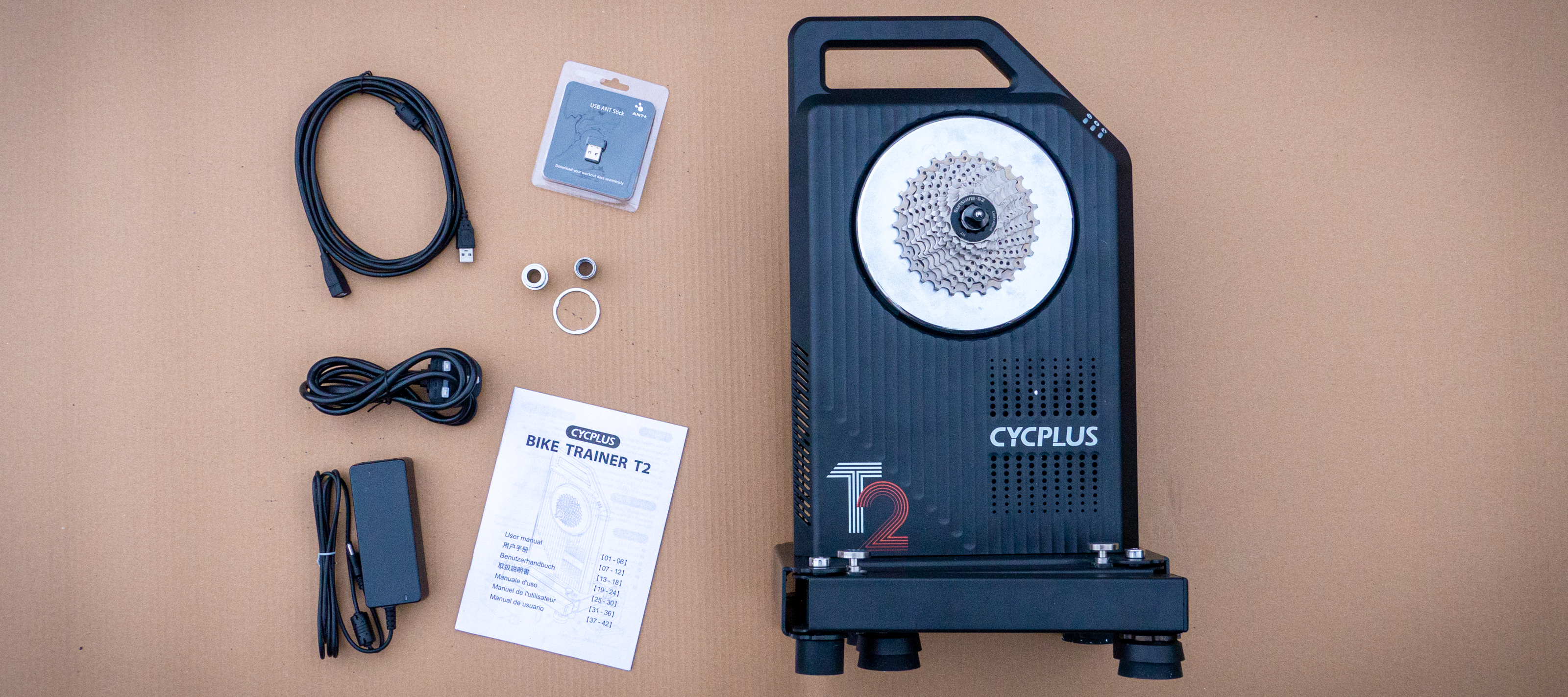Cyclingnews Verdict
Promising value with some impressive features, but comes up short on the basics
Pros
- +
Can be used without mains power
- +
Low weight, folding legs and well-distributed weight make it easy to move
- +
Motor-driven flywheel keeps it spinning down virtual hills
- +
Calibration not required and power accuracy excellent
Cons
- -
Erg Mode gives up at higher power
- -
Poor tolerances on axle, so some thru axles don't fit
- -
Included cassette was wonky
- -
Electronic resistance causes a 'belt slip' feeling at high torque
- -
Noisy on freewheeling
You can trust Cyclingnews
Over the past few years the pandemic caused cycling, and particularly indoor cycling, to explode in popularity. With it, a variety of new smart turbo trainers came to market and among them is the Cycplus T2, the second iteration from the Chinese brand whose name is perhaps more known for electric tyre inflators.
The Cycplus T2 is designed and specced to compete among the best smart trainers while keeping half an eye on the price. It is sold through AliExpress and Alibaba; two marketplaces that connect far-eastern sellers with western buyers, as well as via its own website with free delivery to the UK and the USA. It's priced at $899.00, although it's currently discounted to $593.54 at AliExpress.
Interestingly, despite being sold primarily through two marketplaces with a reputation in the west for offering great prices but not always with the quality to match, the T2 isn't aiming to be the cheapest. It looks more like a value competitor to the top-tier models like the Wahoo Kickr and the Tacx Neo 2T.
At $899.00, it's Wahoo Kickr Core money, although you'll find the Core on offer too. The spec and feature list, however, suggest it's more Wahoo Kickr, ie the Core's more feature-rich and spendier sibling. Those specs include a motor-driven virtual flywheel similar to what you'll find on the Tacx Neo 2T, 1% power accuracy, automatic calibration and even power regeneration.
But a nine hundred dollar smart trainer from a relatively unknown brand (with a support team thousands of miles away) will need to perform well across all areas if it's to steal market share from the more established brands. To see if it does, I've been putting it to the test over the past few months alongside smart trainers from across the price spectrum, including the low-cost Zwift Hub and Pinnacle HC, and the high-priced new Wahoo Kickr and Elite Justo.
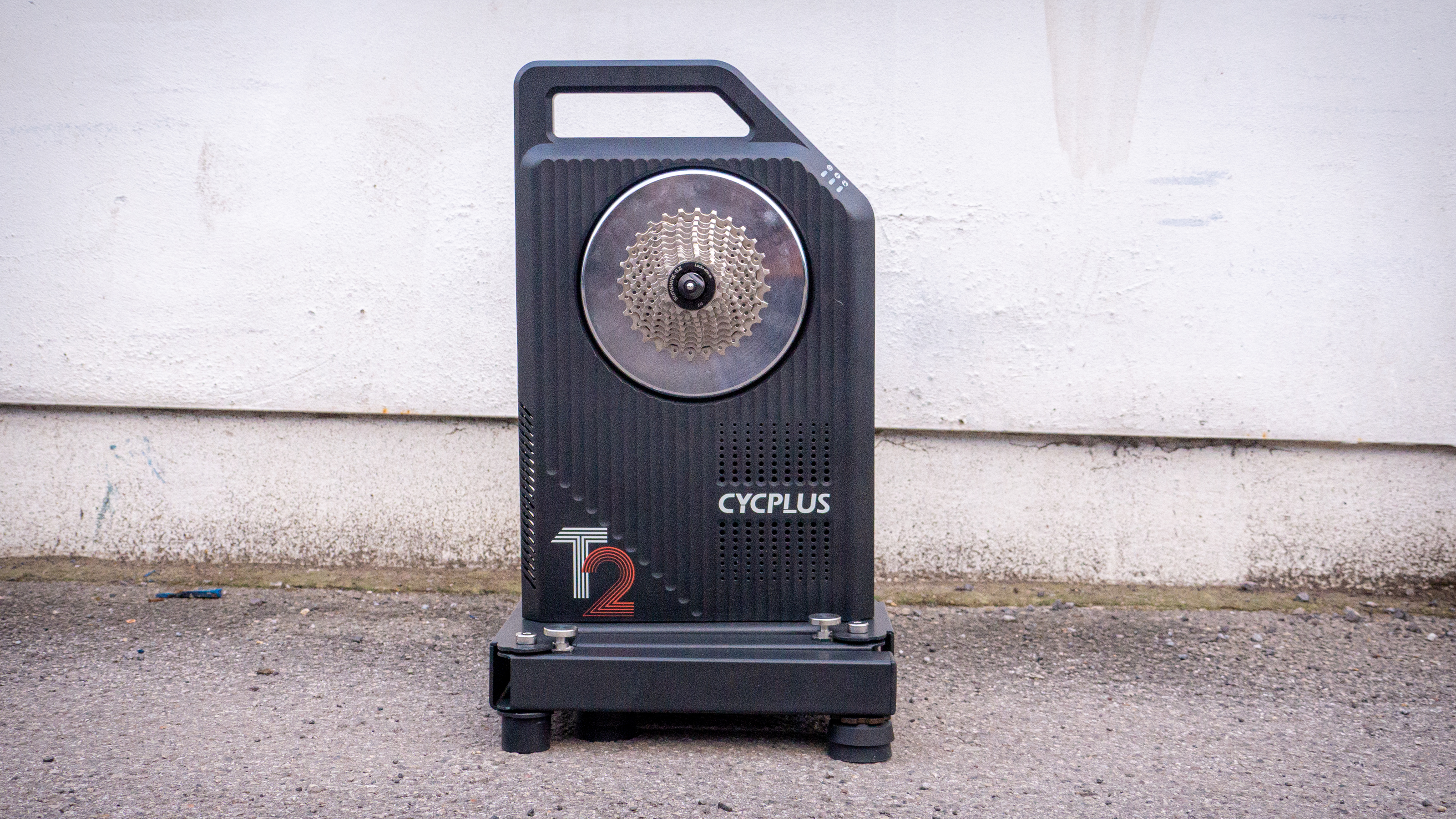
Design and specifications
The main body of the Cycplus T2 is best described as a rectangle stood on its end, but with a corner bitten off and a handle built into what remains. The cassette is mounted directly to a small silver flywheel, which is lightweight with electronic resistance. At the bottom, there are four legs that fold neatly into a square base and extend out to create a large footprint that looks almost spider-like.
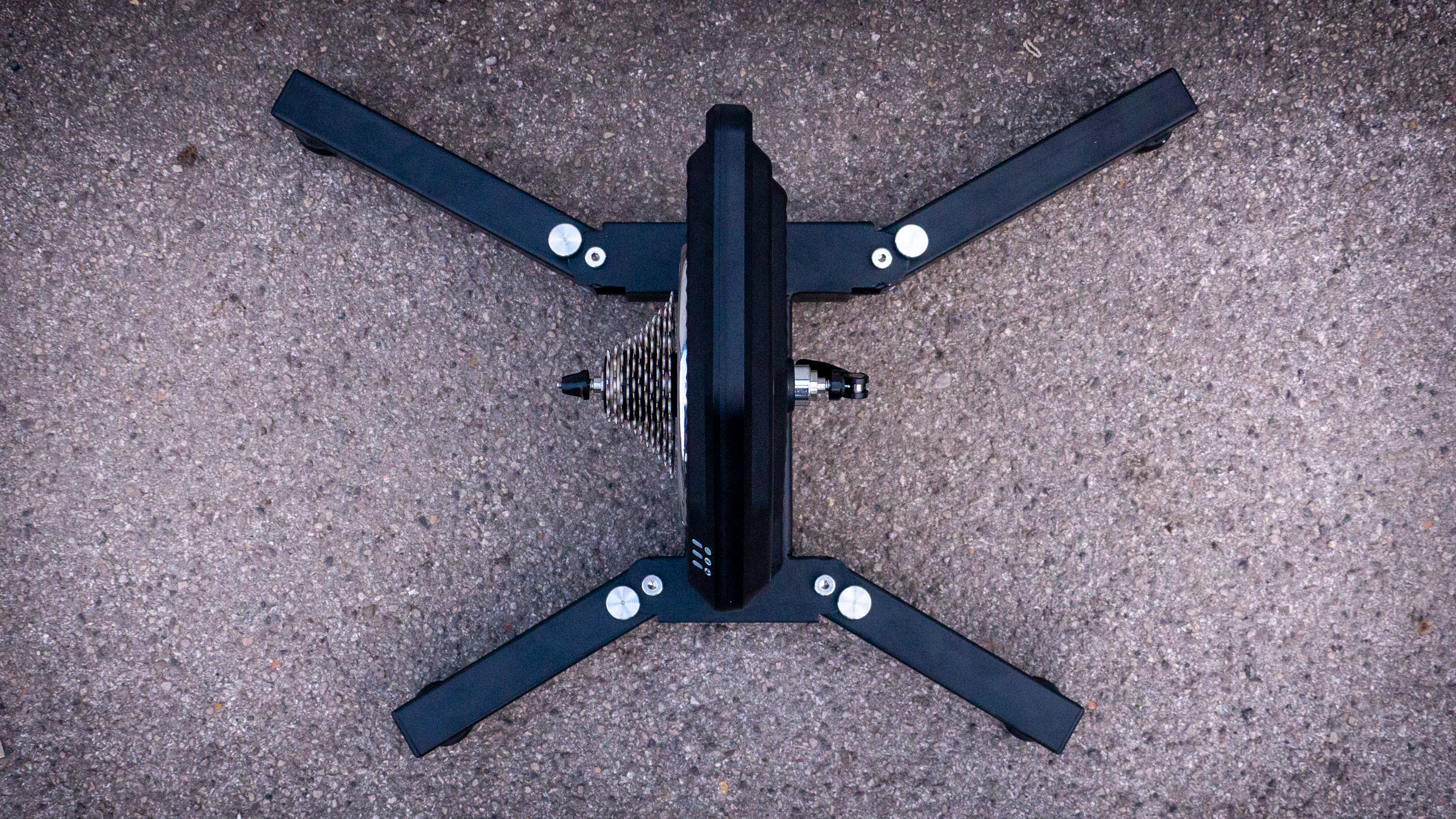
Each leg locks into place with a silver push pin, almost exactly like the ones on the Wahoo Kickr, although they could do with a spray of lubricant upon arrival as they were stiff to push.
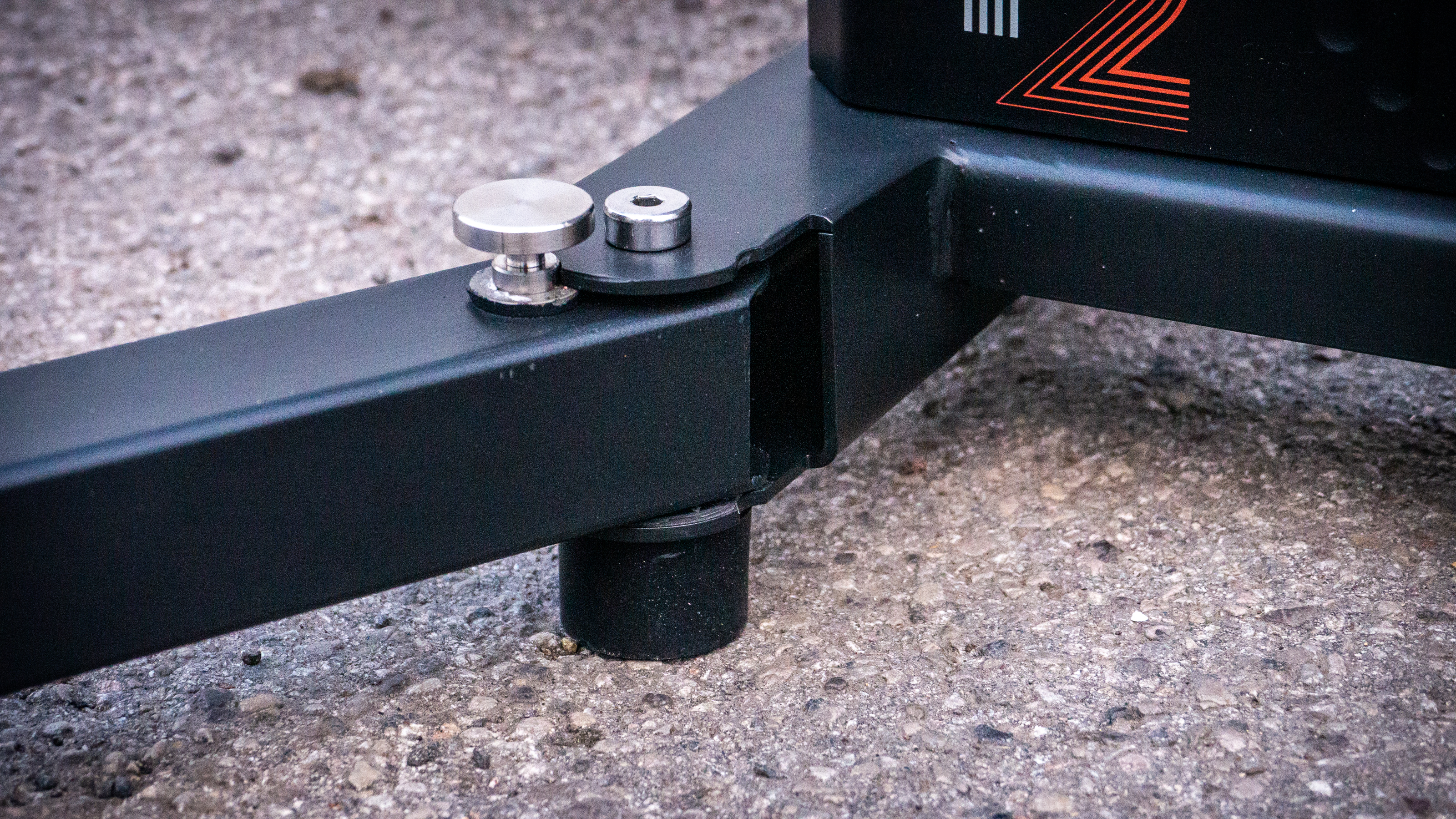
There are eight points of contact with the ground: four in each corner of the static base, and one at the end of each leg. The latter four are height-adjustable. The overall stability is great, though it did have a tendency to shuffle around my hardwood floor when sprinting.
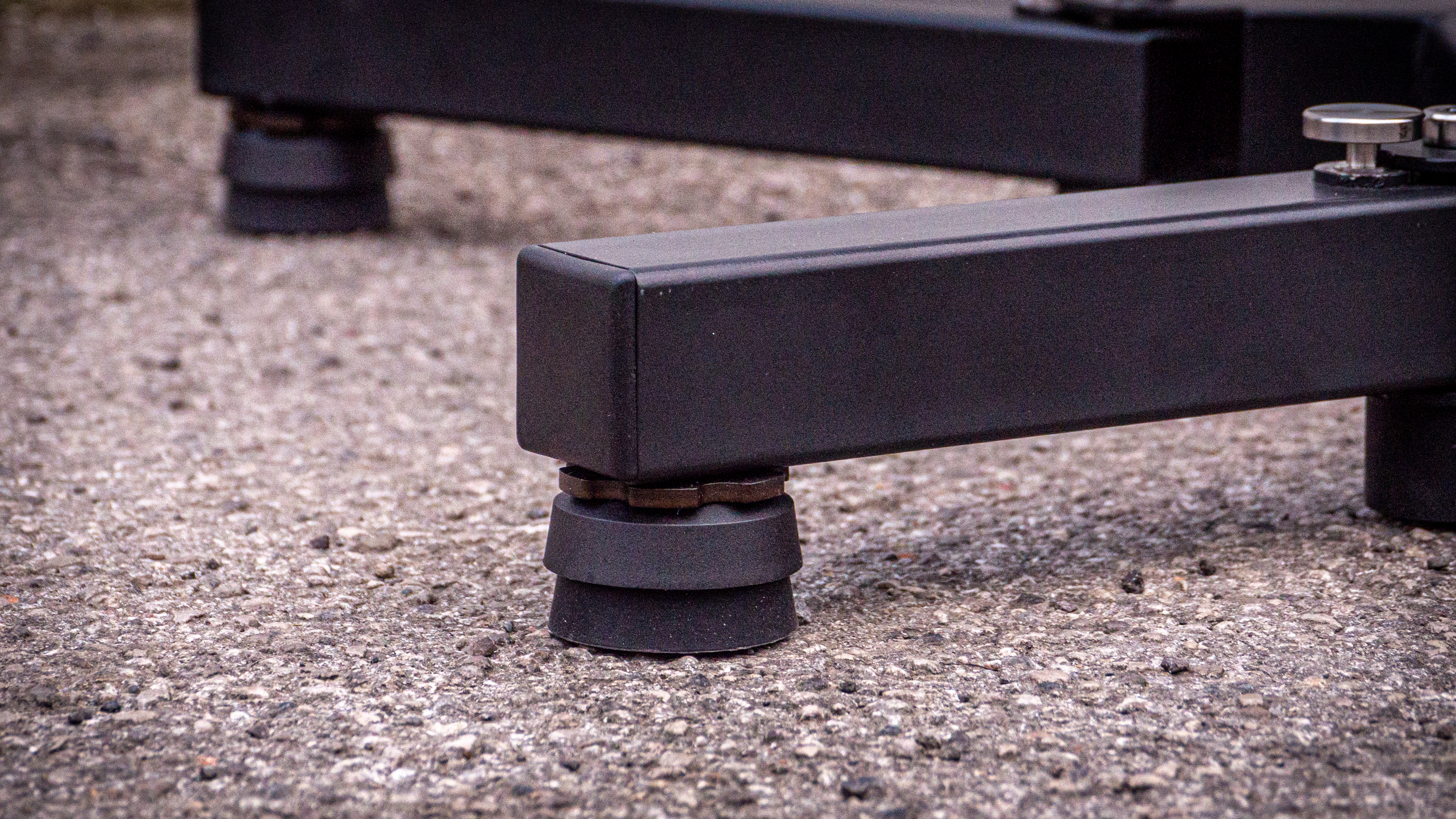
The slight flex through each of the leg pivot points and the soft rubber feet offer a claimed eight degrees of side-to-side movement, and though I've not pulled out the protractor, I'm not in disagreement. It feels as though there's a little more play than the Wahoo Kickr and Elite Justo here, but not enough to become unstable.
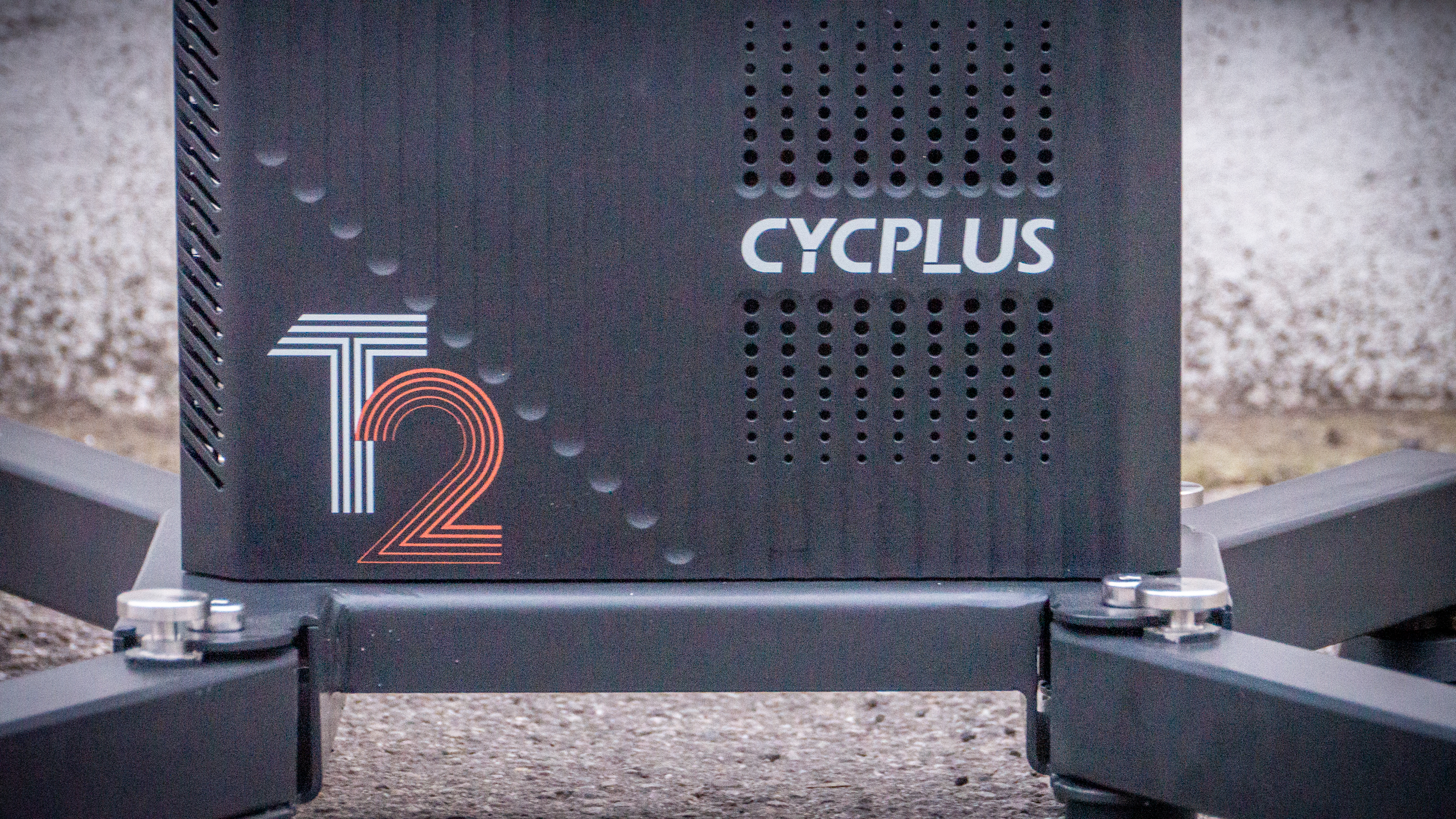
The base and legs are all made from metal, while the main body of the trainer is plastic, dotted with holes presumably to allow heat out. Atop the trainer body are three status lights for Bluetooth, ANT+, and power. The latter was permanently lit when plugged in, as you'd expect, but it's important to note that the T2 can also be used without mains power, and when using it like this the light illuminates after a few pedal strokes.
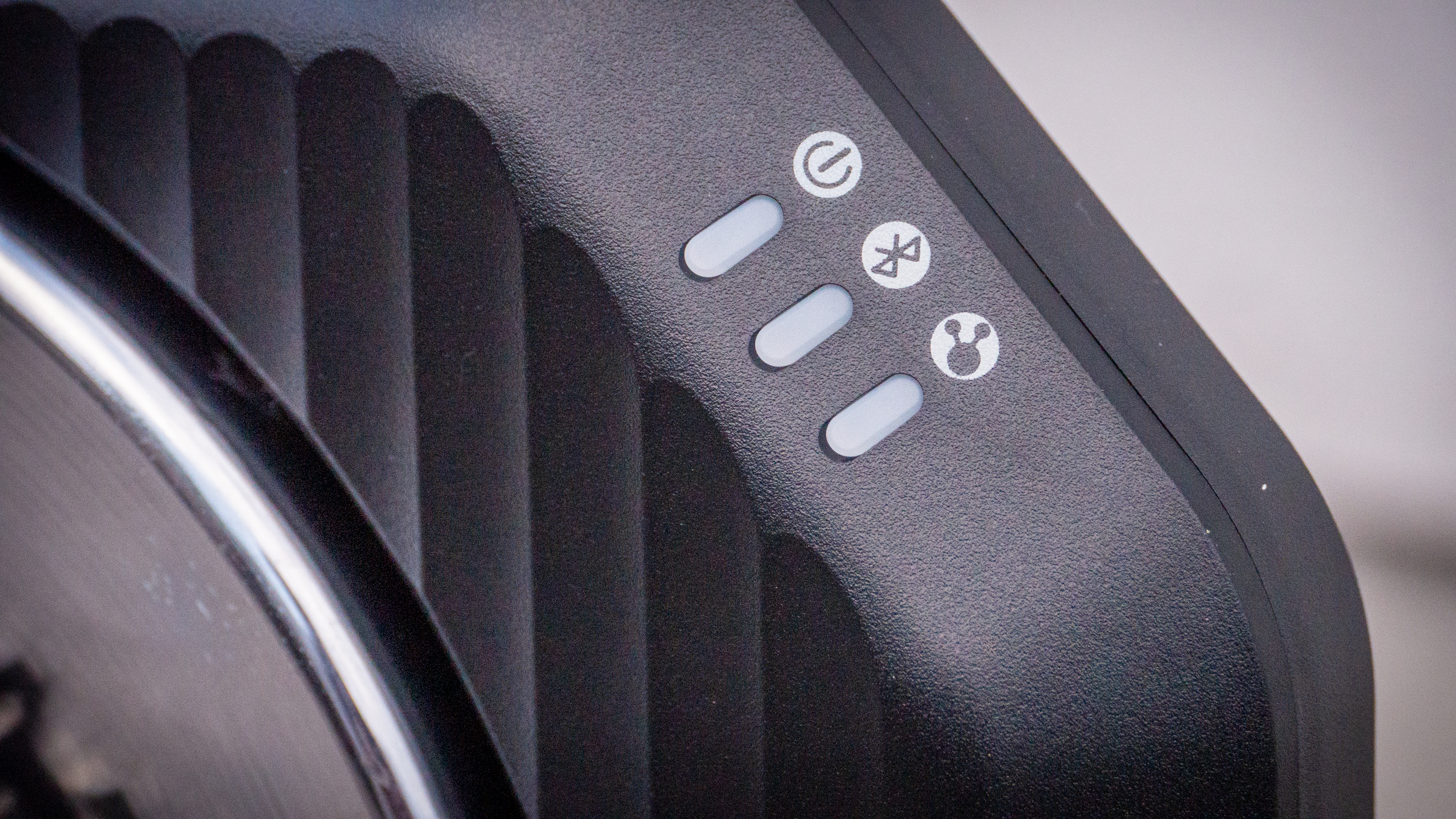
The flywheel is around five inches in diameter, and protrudes by approximately 5mm slightly from the drive side of the trainer. An 11-speed Shimano-compatible 'Sunshine' cassette comes with the trainer, and it mounts directly to the centre of this flywheel. The flywheel is 'motor driven', not unlike the one you'd find on the Tacx Neo 2T. This means there's no physical weight to it, but a simulated inertia controlled by the motor that can actually get faster as you freewheel down a hill in Zwift. It also enables power regeneration, meaning the T2 can be ridden anywhere, even without a source of mains power, and the only loss of functionality is the motor-driven flywheel feature.
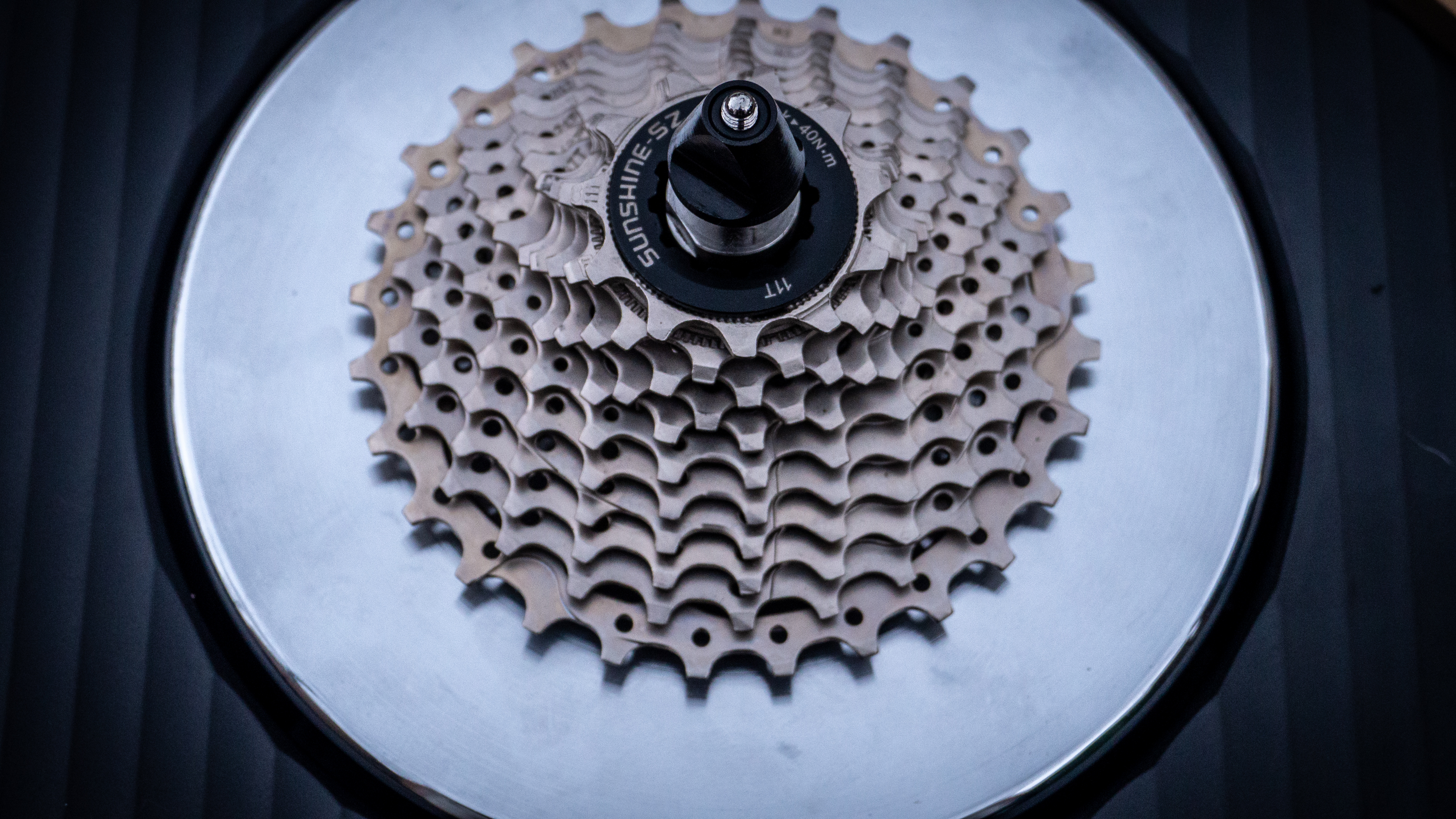
Overall, it weighs 15.5kg, which is a significant 6kg lighter than the Tacx Neo 2T, and 5.5kg lighter than the Wahoo Kickr. It's a touch heavier than the 15kg Zwift Hub, but the handle and compact folded shape makes it much easier to carry and move about.
Performance
I'll get to the point early here, and save you the extra reading: based on my experience with the Cycplus T2, you probably shouldn't buy it over any of the more established products on the market. Sadly, for a company that specialises in inflation, my experience with the T2 has been largely the opposite.
The initial setup seemed promising, and I was impressed with the overall design of the unit; it's compact, fairly lightweight and really easy to carry. All the expected adaptors are present and accounted for, and the power cable is a suitable length. There was even an ANT+ adaptor included, though I never needed to use it. The accompanying app, though largely Chinese, was easy enough to navigate and the firmware was simple to update.
However, when it came to mounting the bike, I hit my first major issue. The bike in question was the Trek Domane SLR 2023 – a review of that is on the way too – and although the bike went on without issue, the thru axle would not go through the middle of the trainer. It would get half way through, then hit an area where it inexplicably narrowed, and short of hitting it with a mallet, wouldn't go through. I didn't fancy explaining to Trek why I'd shattered a thru axle, so tried another bike. The threads on the thru axle for my own Specialized Tarmac SL6 are a little smaller, so that was my next attempt. Successful though it was, it still scraped the narrowed mid-section enough to scratch the paint off the thru-axle. A sign of poor engineering tolerance and a lack of quality control.
Once set up, I set about a few power comparison tests, but not before I hit another problem. The pre-fitted 11-speed Shimano-compatible 'Sunshine' cassette immediately caused shifting issues. I initially thought I'd mistakenly left a spacer on the freehub, but after swapping to a Shimano 105 cassette, the problem subsided. On closer inspection, the cassette was best described as wonky and each sprocket would wave from left to right on rotation like a buckled wheel.
With the problem behind me, it was onto the power tests.
The first test was a fairly low-intensity Z2 ride, TrainerRoad's 'Beech -1'. This features long steady efforts at easy power outputs, and I compared against my usual S-Works Power cranks and Speedplay Powrlink pedals.
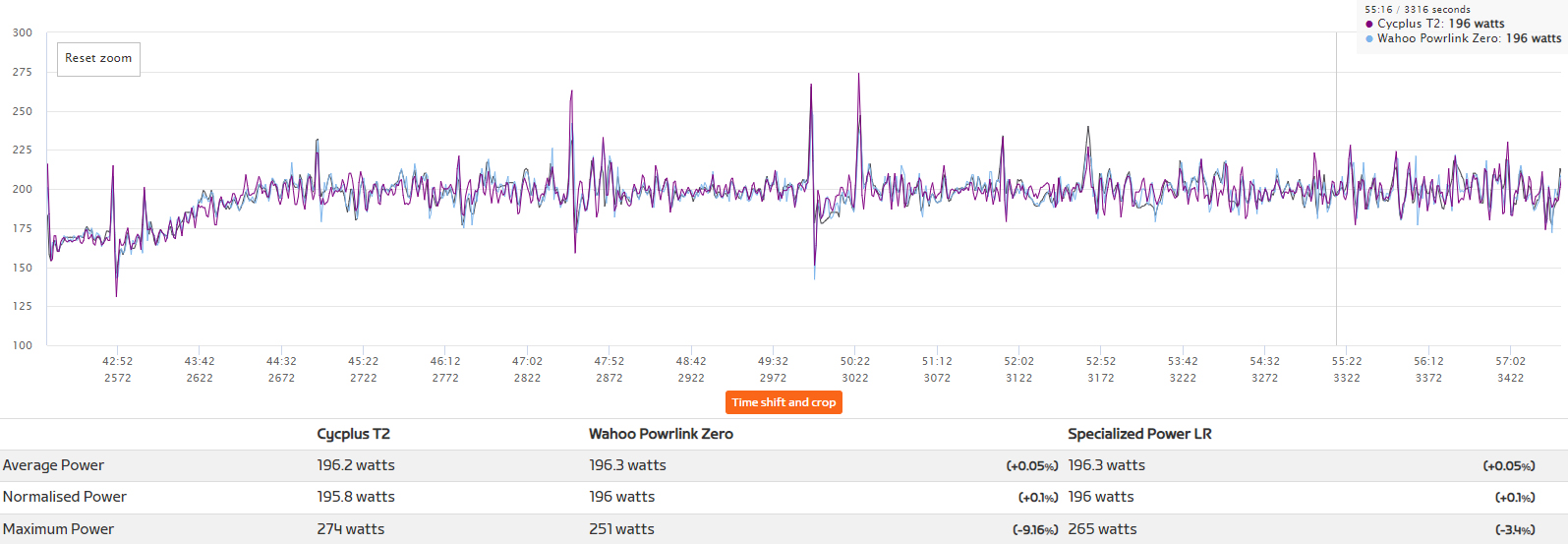
Cutting out this part of the ride, where consistent data was available, the difference in power across the three power meters was just a tenth of a watt. An impressive start.
The second test, as always, is one to check the responsiveness of the trainer in Erg mode. Here, I chose Trainerroad's 'Striped -4' and compared the power to the Speedplay Powrlink pedals.
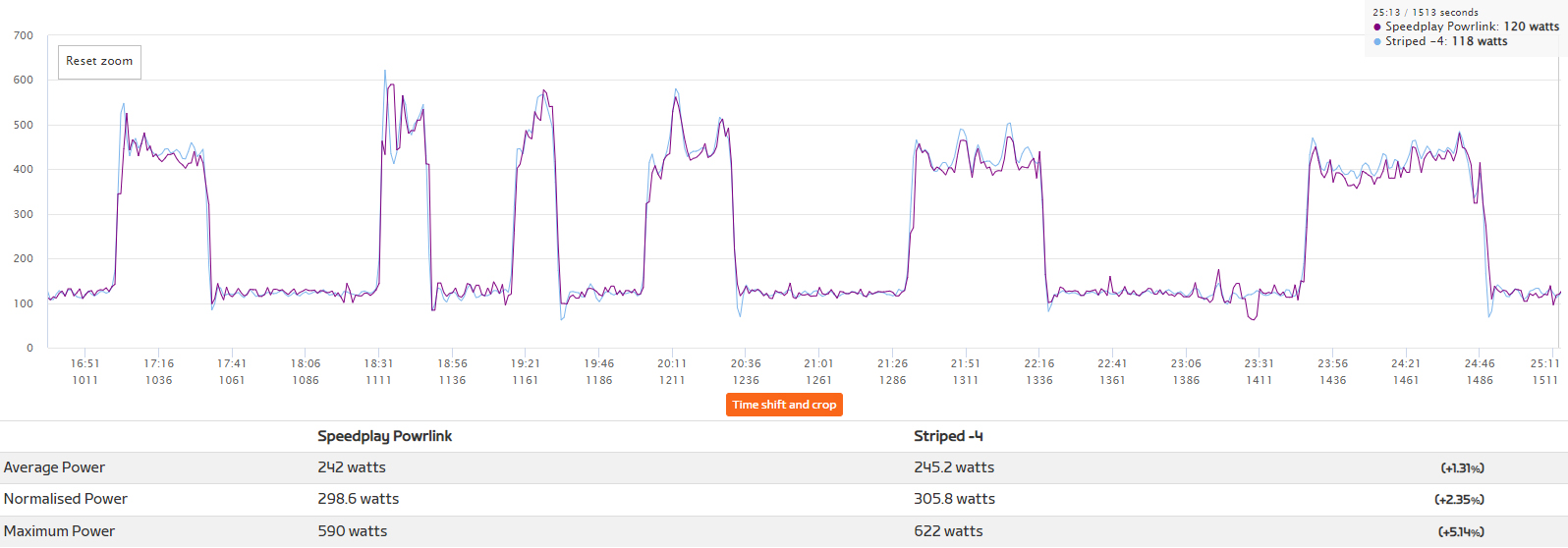
Another cut-out here looks positive: the difference between the power meters is just a few watts, and the two graphs track with each other impressively closely.

However, towards the end of 'Striped -4', I performed my next test and intentionally failed the workout. Specifically, the aim here is to incite the 'spiral of doom' to see how the resistance responds to low cadences. Strangely, nothing really happened, and I was allowed to continue at a wattage below target and an uncomfortably slow cadence. Given the short nature of the interval, I wanted to back this up with another test.
Time to bring out the big guns: the Ramp Test. Minute-long steps at ever-increasing power, keep pedalling until you can pedal no more.

To backwards calculate the torque x speed = power equation, Erg mode is supposed to ramp up resistance (and thus torque) at lower cadences. It added some, and then some more, but as my power began to plateau, and my cadence began dropping, it just kind of stopped adding more resistance and left me wallowing at whatever power I fancied. This pretty much nullified the result of the ramp test, and was a large fail for the Cycplus T2's Erg mode.
Following this, I thought I would spend a little more time using it in races and free rides on Wahoo SYSTM, Zwift, and RGT to give it some time in different 'environments' to reveal any strengths or further weaknesses. Unfortunately, it was more of the latter.
Firstly, in relation to the motor-driven flywheel. Primarily, it's pretty loud, like a noisy freehub. Secondly, it continues to spin long after your in-game avatar has stopped moving, and thirdly, it seemed to offer little in the way of actual inertia when I wanted it most, when the time came to pedal again after a period of descending, there was still a resistance to overcome. None of these are dealbreakers in their own right, though, and the fact that its inclusion means you can use it without mains power might actually be a net positive.
Finally, when trying to go hard up a steep virtual hill and when attempting a sprint, the resistance unit of the T2 seemed to skip a beat. During the downward pedal stroke at certain times, the resistance would almost bite, release, and then bite again, like a wheel spinning or belt slipping. This was pretty much exactly the same feeling I got from the Peloton Bike review. It happened most consistently when sprinting at 800+ watts, but also when in a low gear (Eg. 36 x 28) where the inertia (virtual as it may be) was at its lowest and torque was higher.
Verdict
All in all, there are a few areas where the Cycplus T2 outshines even the best competitors on the market, but unfortunately a lot more areas where it falls short. Its physical form is excellent, with wide legs that provide a super stable base, before folding away to create a compact, balanced unit that's easier than most to move around.
What's more, power accuracy has been excellent, within 0.05% of my other power meters in some tests, and that's impressive given the room temperature during my testing has ranged from 20C in late summer down to -4C in the recent cold snap.
However, unfortunately, a number of issues plague the unit, led by the quality control in the engineering of the axle; the fact that some thru-axles need to be hammered into place should really have been the end of the review, but I persisted. The slipping-belt feeling, wonky cassette and failing Erg mode were just further issues, and despite the overall experience of the Cycplus T2 being a functional turbo trainer that does perform its duties in the most part, it's not worth the price when you can get a Kickr Core for the same money, the Zwift hub for £449 / $499, or one of many turbo trainer deals on once-higher-priced models.
| Attributes | Notes | Rating |
|---|---|---|
| Ease of Use | Setup looked promising in the beginning, with a prefitted cassette and easy fold-out legs, but the thru axle wouldn't fit through the hole and the cassette was wonky, so it was more of a headache than most. Beyond those problems, the day to day use was straightforward, with the app also simple to navigate. | 2/10 |
| Erg Mode | Largely pointless for higher-power intervals | 0/10 |
| Ride Feel | The 'belt slip' feeling at higher torques let it down | 4/10 |
| Power accuracy | Among the best smart trainers I've used in this regard | 10/10 |
| Connectivity | No issues when connecting, no dropouts, no complaints! | 10/10 |
| Noise | In normal use, it's as quiet as the competition, until you start freewheeling, and the motorised flywheel adds a freehub-like clicking | 5/10 |
| Stability | Nice and stable, with a wide base, but with a tendency to shuffle around hardwood floors | 6/10 |
| Storability | Lightweight, with a compact size and balanced weight distribution makes it great for moving and storing | 10/10 |
| Value | Given it's functionally flawed in many ways, the price is far from good value | 1/10 |
| Total | Row 9 - Cell 1 | 54% |

Josh is Associate Editor of Cyclingnews – leading our content on the best bikes, kit and the latest breaking tech stories from the pro peloton. He has been with us since the summer of 2019 and throughout that time he's covered everything from buyer's guides and deals to the latest tech news and reviews.
On the bike, Josh has been riding and racing for over 15 years. He started out racing cross country in his teens back when 26-inch wheels and triple chainsets were still mainstream, but he found favour in road racing in his early 20s, racing at a local and national level for Somerset-based Team Tor 2000. These days he rides indoors for convenience and fitness, and outdoors for fun on road, gravel, 'cross and cross-country bikes, the latter usually with his two dogs in tow.
